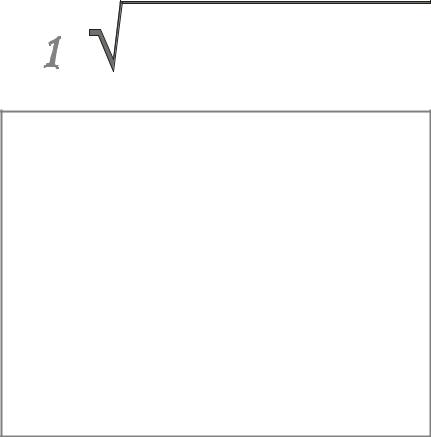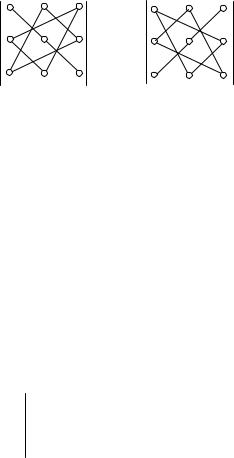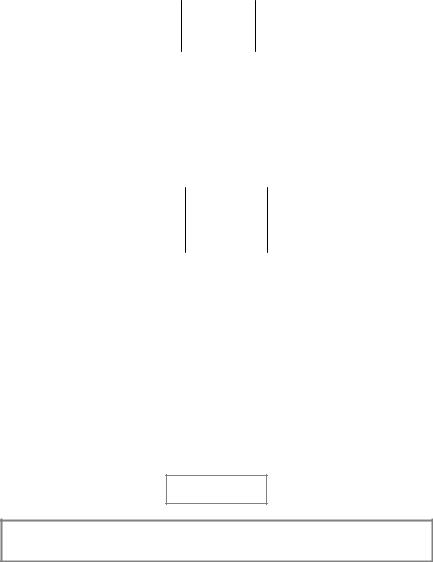
Higher_Mathematics_Part_1
.pdf
Part 1
Manual
Kyiv
National Aviation University
«NAU-druk» Publishing
2009
http://vk.com/studentu_tk, http://studentu.tk/
UDC 513.123:517.2=111(075.8)
ББК В10я7
Н 65
All rights reserved. No part of this book may be reproduced in any form without the prior written permission of the publisher
Authors:
V.P. Denisiuk, L. I. Grishina, O. V. Karupu, T. A. Oleshko, V. V. Pakhnenko, V. K. Repeta
Reviewers:
O. P. Besklinska — candidate of science (physics and mathematics), associate professor (Kyiv National Linguistic University)
P.T. Kachanov — candidate of science (engineering), associate professor (State University of Information and Communication Technologies)
English language adviser
O. Yu. Kravchuk, associate professor
Approved by the Methodical
and Editorial Board of the National Aviation University (Minutes № 8/09 of 17.12.2009)
The manual fully corresponds to the educational program of higher mathematics for engineering universities. It contains basic theoretical information, examples of problems solution, class, home and self-test assignments.
The manual is intended for the first course students of all specialities.
ISBN 978–966–598–612–6 |
© Denisiuk V. P., Grishina L. I., |
Karupu O. V. and fo on, 2009 |
|
ISBN 978–966–598–614–0 (Part 1) |
© NAU, 2009 |
http://vk.com/studentu_tk, http://studentu.tk/

INTRODUCTION
This book offers the modular technology of studying higher mathematics course by the students of engineering specialties in the first term.
The module represents the logically compiled sections of studied subject. The material of the first term is divided into three modules:
1.Elements of linear and vector algebra.
2.Elements of analytical geometry.
3.Introduction to mathematical analysis. Derivatives and differentials of a function of one variable. Applications of derivatives.
Each module contains several micromodules.
Every module begins with the general statements, which represent the themes of the sections, basic concepts, and main tasks.
Each micromodule covers:
1)basic theoretical information,
2)examples of problem solutions,
3)class and home assignments,
4)self-test assignments.
The theoretical part gives all necessary material for mastering the theme in questions (lecture summary). The references to the literature are applied to all the themes, which enable the students to master their theoretical material.
The practical part contains examples of problem solutions, that illustrate the theoretical material and problems with answers for class and home work.
Each micromodule is provided with self-test assignments which contain several problems to be done by the students in a written form.
3
http://vk.com/studentu_tk, http://studentu.tk/

Моdule
1
ELEMENTS OF LINEAR AND VECTOR ALGEBRA
MODULE STRUCTURE
Micromodule 1. Determinants. Determinants of 2nd and 3rd orders. Properties of determinants. Minors and cofactors. General definition of a determinant of order n. Calculation of determinants.
Micromodule 2. Matrices. Definition of a matrix, operations with them. Inverse matrix. Matrix equations. Rank of a matrix and its property.
Micromodule 3. Systems of linear algebraic equations. Investigation of the behaviour of a linear algebraic equations System. Consistence (compatibility), investigation of consistence by matrix rank. Solution of the systems by Cramer’s rule, matrix method, Gauss’ method. Indefinite systems and their solutions. Homogeneous systems of linear algebraic equations. Eigenvalues and eigenvectors of matrix.
Micromodule 4. Vectors. Vectors, linear operations with vectors. Projection of vector on axis. Linear dependence and independence of vectors. Basis and coordinate system. Vectors in Cartesian coordinate system. Division of line segment according to a given ratio.
Micromodule 5. Dot Product. Definition of the dot product, it’s properties and coordinate form. Two vectors perpendicularity condition.
Micromodule 6. Cross and Triple Products. Cross product, it’s algebraic and geometrical properties. Coordinate form. Triple product, it’s algebraic and geometrical properties. Coordinate form. Three vectors complanarity condition.
Basic concepts. 1. Determinant. 2. Matrix. 3. System of Linear Algebraic Equations (SLAE). 4. Vector. 5. Projection of vector. 6. Basis. 7. Cartesian Coordinate System. 8. Vector coordinates. 9. Dot product. 10. Cross product. 11. Triple product.
Key word: determinant — визначник, matrix — матриця, minor — мінор, cofactor — алгебраїчне доповнення, permutation of elements — перестановка елементів, inverse matrix — обернена матриця, rank — ранг, homogeneous systems — однорідні системи, vector — вектор, eigenvalues — власні значення, eigenvectors — власні вектори, linear dependence — лінійна залежність, linear independence — лінійна незалежність, basis — базис, expansion of a vector in terms of base vectors — розклад вектора по базисним векторам, the Cartesian rectangular system of coordinates — прямокутна система координат, dot product (scalar product) — скалярний добуток, cross
4
http://vk.com/studentu_tk, http://studentu.tk/
product (vector product) — векторний добуток, triple product (mixed product) — мішаний добуток, collinear vectors — колінеарні вектори, coplanar vectors —
компланарні вектори, orthogonal vectors — ортогональні вектора
Main tasks. 1. Calculation of determinants. 2. Solution of Linear algebraic equations system. 3. Matrix equation solution. 4. Investigation of the linear algebraic equations systems. 5. Operations with vectors. 6. Mutual disposition of vectors. 7. Dot, cross and triple product usage in solving geometrical problems.
A STUDENT MUST BE READY TO DO
THE FOLLOWING ASSIGNMENTS
1. Concepts, definitions, formulations:
•Determinants of the 2nd, the 3rd and the n-th orders.
•Matrices. Linear operations with matrices. Multiplication of matrices.
•Inverse matrix.
•Minors, rank of matrix.
•Definite, indefinite, consistent, inconsistent SLAE.
•Matrix form of SLAE.
•Gauss’ method of SLAE solution.
•Kronecker-Capellі theorem usage in SLAE investigation.
•Eigenvalues and eigenvectors of matrix.
•Geometrical vector. Vector addition and subtraction operations, multiplication by scalar.
•Linear dependence and independence of vectors.
•Basis on a plane and in space.
•Cartesian coordinate system (CCS).
•Dot product of two vectors.
•Cross product of two vectors.
•Triple product.
2. Proofs and conclusions
•Properties of determinants (2nd and 3rd orders).
•Matrix addition and multiplication properties.
•Existence of an inverse matrix.
•Inverse matrix method of SLAE solution.
•Cramer’s Theorem.
•Kronecker-Capellі Theorem.
•Projection of vector on axis.
•Representation of a vector in terms of base vectors.
•Properties of a dot product; calculation by coordinates.
•Properties of a cross product; calculation by coordinates.
•Properties of a triple product; calculation by coordinates.
5
http://vk.com/studentu_tk, http://studentu.tk/

3. Assignments
•Calculate the determinants of order 2, 3 and n, to be able to lay out a determinant by the elements of any row or column, to reduce determinant to the triangle form.
•Find the matrix sum, difference and product.
•Find the matrix rank.
•Find an inverse matrix.
•Solve the square systems by Cramer’s method, through inverse matrix.
•Solve the arbitrary SLAE by Gauss’ method.
•Analyse SLAE on the consistence (compatibility) according to KroneckerCapellі Theorem.
•Find the eigenvalues and eigenvectors of matrix.
•Find the vector coordinates, it’s length, unit vector. Find the angle between vectors.
•Find the vector sum, difference, dot and cross products.
•Calculate the area of the triangle, volume of pyramid.
•Be able to represent the vector in terms of base vectors .
•Be able to use the condition of two vectors perpendicularity.
Micromodule 1
BASIC THEORETICAL INFORMATION. DETERMINANTS
Determinants of the 2nd and the 3rd orders. Properties of determinants. Minor and cofactor. General definition of a determinant of the n-th order. Calculations of determinants.
Literature: [1, chapter 1], [4, part 2, p.2.3], [6, chapter 1 §1], [7, chapter 2 §7], [10, chapter 1 §2] [11, chapter 1 §1].
1.1. Determinants of the 2nd and the 3rd orders
Definition 1.1. A number
= |
a11 |
a12 |
= a a − a a |
21 |
||
|
a21 |
a22 |
11 |
22 |
12 |
|
|
|
|
|
|
||
is the determinant of the 2nd order.
Such determinants appear to be true, for example, for the solution of such linear systems as
a11 x1 + a12 x2 = b1 ,a21 x1 + a22 x2 = b2 .
6
http://vk.com/studentu_tk, http://studentu.tk/

Let’s find x . We multiply both parts of the first equation by a22 , and of the 2nd equation by ( −a12 ), whereupon, by adding the left-hand and right-hand sides of the given equations, we get the equality
a22 (a11 x1 + a12 x2 ) − a12 (a21 x1 + a22 x2 ) = a22b1 − a12b2 ,
which, after simplifications, we obtain
(a22 a11 − a12 a21 )x1 = a22b1 − a12b2 .
In the case of condition a22 a11 − a12 a21 ≠ 0 , we get
|
|
|
|
|
|
|
|
|
|
|
|
|
b1 |
a12 |
|
|
|
|
|
|
|
a |
b − a |
b |
|
|
|
|
|
b2 |
a22 |
|
|
|
|
|
|||
x1 |
= |
22 |
1 |
12 |
|
2 |
= |
|
|
|
|
|
|
|
|
|
. |
||
a22 a11 |
− a12 a21 |
|
|
a11 |
a12 |
|
|
|
|||||||||||
|
|
||||||||||||||||||
|
|
|
|
|
|
|
|
|
|
|
|||||||||
By eliminating variable x1 , we get |
|
|
|
|
|
|
a21 |
a22 |
|
|
|
|
|
||||||
|
|
|
|
|
|
|
|
a11 |
b1 |
|
|
|
|
|
|||||
|
|
|
|
|
|
|
|
|
|
|
|
|
|
|
|
|
|
||
|
|
|
|
|
|
|
|
|
|
|
|
|
|
|
|
|
|
||
|
|
a |
b |
− a |
|
b |
|
|
|
|
|
|
a21 |
b2 |
|
|
|
|
|
x2 |
= |
11 |
2 |
21 |
1 |
|
= |
|
|
|
|
|
|
|
|
|
|
. |
|
a22 a11 |
− a12 a21 |
|
|
|
|
a11 |
a12 |
|
|
|
|||||||||
|
|
|
|
|
|||||||||||||||
|
|
|
|
|
|
|
|
|
|
|
|
||||||||
|
|
|
|
|
|
|
|
|
|
|
a21 |
a22 |
|
|
|
|
|
||
So, the solutions of the given system are expressed through the determinants of the 2nd order.
Definition 1.2. A number
a11 a12 a13
= a21 a22 a23 = a11a22 a33 + a12 a23a31 + a13a21a32 − a31 a32 a33
−a13 a22 a31 − a11a23 a32 − a12 a21a33 .
is called the determinant of the 3rd order.
The order of determinant equals to the number of its rows or columns.
The numbers aij are elements of a determinant thus the first index i indicates a
number of row, and the 2nd index j is a number of column, in which the element lies. Elements a11 , a22 in the determinant of the 2nd order and a11 , a22 , a33 of the
determinant of the 3rd order, all together, form a principal (leading) diagonal of a determinant and elements a12 , a21 and a13 , a22 , a31 form a secondary diagonal.
For the calculation of determinant of the 2nd order it is necessary to subtract the product of all elements of a secondary diagonal from the product of elements of a principal diagonal.
7
http://vk.com/studentu_tk, http://studentu.tk/

The determinant of the 3rd order is calculated by the rule of triangle. First three multipliers with a sign plus are the product of all elements of a principal diagonal and in the tops of two triangles in which one side is parallel to the principal diagonal. Next three multipliers with a sign minus are the product of elements of a secondary diagonal and in the tops of two triangles in which one side is parallel to secondary diagonal.
To remember this formula it is advisable to use the scheme represented in Fig. 1.1.
+ |
– |
Fig. 1.1
Remark. It is important to know the following formula. If a determinant is upper (lower) triangular form, then this determinant is equal to the product of all elements of the principal diagonal, for example
|
a11 |
a12 |
a13 |
|
= a11a22a33. |
|
|
||||
= |
0 |
a22 |
a23 |
|
|
|
0 |
0 |
a33 |
|
|
|
|
|
|
|
|
1.2. Principal properties of determinants
We shall formulate the properties for the third-order determinants, although they are true for determinant of any order.
1. The value of a determinant does not vary if its rows and columns are interchanged.
a11 |
a12 |
a13 |
|
a11 |
a21 |
a31 |
|
a21 |
a22 |
a23 |
= |
a12 |
a22 |
a32 |
. |
a31 |
a32 |
a33 |
|
a13 |
a23 |
a33 |
|
Property 1 establishes the equivalence of the rows and columns of a determinant.
2. Interchanging of two rows or of two columns of a determinant is equivalent to its multiplication by –1.
8
http://vk.com/studentu_tk, http://studentu.tk/

For example,
a11 |
a12 |
a13 |
|
|
a |
a |
a |
|
|
|
|
|
|||||||
|
|
|
|
|
31 |
32 |
33 |
|
|
a |
a |
a |
= |
− |
a |
a |
a |
|
. |
21 |
22 |
23 |
|
|
21 |
22 |
23 |
|
|
a31 |
a32 |
a33 |
|
|
a11 |
a12 |
a13 |
|
|
|
|
|
|
|
|
|
|
|
|
3.If all elements of a row (or a column) of a determinant are zero, then the determinant itself is zero.
4.If a determinant has two identical rows (or columns), then it is equal to zero.
5.The product of all elements of one column or one row of a determinant by any number k is equivalent to the multiplication of the determinant by this number.
For example,
a11 |
ka12 |
a13 |
|
a11 |
a12 |
a13 |
|
a21 |
ka22 |
a23 |
= k |
a21 |
a22 |
a23 |
. |
a31 |
ka32 |
a33 |
|
a31 |
a32 |
a33 |
|
6.If the elements of two rows (or columns) of a determinant are proportional then the determinant is zero.
7.If every element of the i-th row (or j-th column) of a determinant is the sum of two terms, then the determinant can be represented as the sum of two determinants.
For example,
a′ |
+ a′′ |
a′ |
+ a′′ |
a′ |
+ a′′ |
|
′ |
′ |
|
′ |
|
a′′ |
a′′ |
a′′ |
|
|
|
|
|
||||||||||||
11 |
11 |
12 |
12 |
13 |
13 |
|
a11 |
a12 |
a13 |
|
|
||||
|
|
|
|
|
|
|
|
|
|
|
|
11 |
12 |
13 |
|
a |
a |
a |
= |
a |
a |
a |
23 |
+ |
a |
a |
a |
. |
|||
|
21 |
|
22 |
|
23 |
|
21 |
22 |
|
|
21 |
22 |
23 |
|
|
a31 |
a32 |
a33 |
|
a31 |
a32 |
a33 |
|
a31 |
a32 |
a33 |
|
||||
|
|
|
|
|
|
|
|
|
|
|
|
|
|
|
|
8. If the elements of a row (or a column) of a determinant are summed up with the elements of another row (column) multiplied by any common factor k, then the value of the determinant remains unchanged.
For example,
|
|
|
|
|
|
|
a11 + ka21 |
a12 + ka22 |
a13 + ka23 |
|
|
|
|
|
|
|
|
||||||||
|
|
|
|
|
|
|
|
|
|
|
|
|
|
|
|||||||||||
|
|
|
|
|
|
|
a21 |
a22 |
|
|
a23 |
|
= |
|
|
|
|
|
|
||||||
|
|
|
|
|
|
|
a31 |
a32 |
|
|
a33 |
|
|
|
|
|
|
|
|
||||||
|
a |
a |
a |
|
ka |
ka |
ka |
|
|
a11 |
a12 |
a13 |
|
|
|
|
|
a |
a |
a |
23 |
|
|||
|
|
|
|
|
|
|
|||||||||||||||||||
|
|
|
|
|
|
||||||||||||||||||||
= |
11 |
12 |
13 |
+ |
21 |
22 |
23 |
|
= |
a |
|
a |
a |
|
|
+ k |
|
21 |
22 |
|
= |
||||
a |
21 |
a |
22 |
a |
a |
a |
a |
|
21 |
|
|
|
a |
a |
a |
23 |
|||||||||
|
|
|
23 |
|
21 |
22 |
23 |
|
|
|
22 |
23 |
|
|
|
|
21 |
22 |
|
|
|||||
|
a31 |
a32 |
a33 |
|
a31 |
a32 |
a33 |
|
|
a31 |
a32 |
a33 |
|
|
|
|
|
a31 |
a32 |
a33 |
|
||||
9
http://vk.com/studentu_tk, http://studentu.tk/

a11 a12 a13 = a21 a22 a23 .
a31 a32 a33
All properties of determinants of order 3 are true for the determinants of any order.
1.3. Expansion of a determinant by the elements of the row or the column
Let’s consider a determinant of order 3
a11 a12 a13
= a21 a22 a23 . a31 a32 a33
Definition 1.3. The Minor Мij of an element aij of a determinant of order n
is a determinant of order (n – 1) obtained from the given determinant by striking out a row i and a column j in which the element lies.
For instance, the minor of the element a23 of the determinant ∆ is the
second-order determinant |
M |
23 |
= |
a11 |
a12 |
. The minor of the element a is the |
||||
|
|
|
|
|
a31 |
a32 |
31 |
|||
second-order determinant |
M31 |
= |
|
a12 |
a13 |
|
. |
|||
|
|
|||||||||
|
|
|
|
|
a22 |
a23 |
|
|
||
Definition 1.4. The Cofactor, or algebraic adjunct, Aij of an element aij of a determinant is the minor Мij of that element multiplied by (−1)i+ j :
Aij = (−1)i+ j Mij .
Laplas’ Theorem 1.1. A determinant is equal to the sum of the products of all elements of a row or of a column by their cofactors.
For example, for the determinant of the 3rd order such equalities are executed:
= a11 A11 |
+ a12 A12 + a13 A13 |
(expansion by the elements of the first row); |
= a12 A12 |
+ a22 A22 + a32 A32 |
(expansion by the elements of the second |
column).
10
http://vk.com/studentu_tk, http://studentu.tk/
